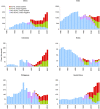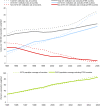Has the DOTS strategy improved case finding or treatment success? An empirical assessment
- PMID: 18320042
- PMCID: PMC2253827
- DOI: 10.1371/journal.pone.0001721
Has the DOTS strategy improved case finding or treatment success? An empirical assessment
Abstract
Background: Nearly fifteen years after the start of WHO's DOTS strategy, tuberculosis remains a major global health problem. Given the lack of empirical evidence that DOTS reduces tuberculosis burden, considerable debate has arisen about its place in the future of global tuberculosis control efforts. An independent evaluation of DOTS, one of the most widely-implemented and longest-running interventions in global health, is a prerequisite for meaningful improvements to tuberculosis control efforts, including WHO's new Stop TB Strategy. We investigate the impact of the expansion of the DOTS strategy on tuberculosis case finding and treatment success, using only empirical data.
Methods and findings: We study the effect of DOTS using time-series cross-sectional methods. We first estimate the impact of DOTS expansion on case detection, using reported case notification data and controlling for other determinants of change in notifications, including HIV prevalence, GDP, and country-specific effects. We then estimate the effect of DOTS expansion on treatment success. DOTS programme variables had no statistically significant impact on case detection in a wide range of models and specifications. DOTS population coverage had a significant effect on overall treatment success rates, such that countries with full DOTS coverage benefit from at least an 18% increase in treatment success (95% CI: 5-31%).
Conclusions: The DOTS technical package improved overall treatment success. By contrast, DOTS expansion had no effect on case detection. This finding is less optimistic than previous analyses. Better epidemiological and programme data would facilitate future monitoring and evaluation efforts.
Conflict of interest statement
Figures




References
-
- Raviglione MC, Pio A. Evolution of WHO policies for tuberculosis control, 1948-2001. Lancet. 2002;359:775–780. - PubMed
-
- Lopez AD, Mathers CD, Ezzati M, Jamison DT, Murray CJ. Global and regional burden of disease and risk factors, 2001: systematic analysis of population health data. Lancet. 2006;367:1747–1757. - PubMed
-
- World Health Organization. Geneva: World Health Organization; 2007. Global Tuberculosis Control: surveillance, planning, financing.
-
- Corbett EL, Watt CJ, Walker N, Maher D, Williams BG, et al. The growing burden of tuberculosis: global trends and interactions with the HIV epidemic. Arch Intern Med. 2003;163:1009–1021. - PubMed
-
- Espinal MA, Laszlo A, Simonsen L, Boulahbal F, Kim SJ, et al. Global trends in resistance to antituberculosis drugs. World Health Organization-International Union against Tuberculosis and Lung Disease Working Group on Anti-Tuberculosis Drug Resistance Surveillance. N Engl J Med. 2001;344:1294–1303. - PubMed

